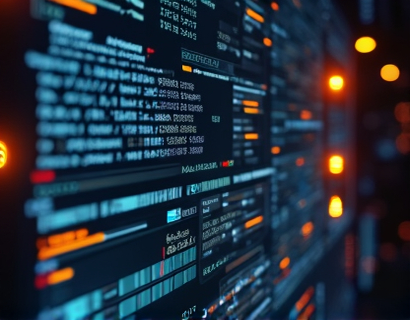Unlocking the Potential of AI and Crypto: Transforming Digital Ecosystems for Enhanced User Experiences
The integration of Artificial Intelligence (AI) and cryptocurrency is revolutionizing the digital landscape, offering unprecedented opportunities for tech innovators and early adopters. This synergy is not just about combining two advanced technologies but creating a powerful ecosystem that enhances user experiences, drives growth, and fosters innovation. In this article, we will delve into the strategic alignment of AI and cryptocurrency, exploring how this combination can unlock new potentials in the modern tech environment.
The digital ecosystem is rapidly evolving, with users demanding more personalized, secure, and efficient interactions. AI, with its capabilities in data analysis, pattern recognition, and predictive modeling, is pivotal in meeting these demands. Meanwhile, cryptocurrency, with its decentralized and secure nature, provides a robust foundation for transactions and data management. When these two technologies converge, they create a synergistic effect that can transform various aspects of digital experiences.
Enhanced Personalization through AI and Crypto
One of the most significant benefits of merging AI and cryptocurrency is the ability to offer highly personalized experiences to users. AI algorithms can analyze vast amounts of user data to understand preferences, behaviors, and needs. This data can be used to tailor content, recommendations, and services to individual users, creating a more engaging and satisfying experience.
Cryptocurrency adds a layer of security and privacy to this process. By using blockchain technology, user data can be stored and managed in a decentralized manner, reducing the risk of data breaches and ensuring user privacy. Smart contracts can automate the process of data sharing and access control, ensuring that users have full control over their information. This combination not only enhances personalization but also builds trust and confidence among users.
Secure and Decentralized Transactions
Security is a paramount concern in the digital world, and the integration of AI and cryptocurrency addresses this issue effectively. Traditional centralized systems are vulnerable to hacking and fraud, whereas a decentralized approach using blockchain technology provides a higher level of security. Each transaction is recorded on a distributed ledger, making it nearly impossible to alter or manipulate data.
AI can further enhance security by detecting and preventing fraudulent activities in real-time. Machine learning algorithms can identify unusual patterns and anomalies, triggering alerts and automated responses to mitigate risks. This proactive approach ensures that transactions are not only secure but also seamless, reducing friction for users.
Smart Contracts and Automated Processes
Smart contracts, powered by blockchain, are self-executing contracts with the terms of the agreement directly written into code. When combined with AI, smart contracts can be programmed to respond to specific conditions and triggers, automating complex processes with precision and efficiency. This automation reduces the need for intermediaries, lowering costs and increasing speed.
For instance, in the context of digital services, smart contracts can automatically manage subscriptions, payments, and access rights based on predefined rules. AI can optimize these processes by predicting user behavior and adjusting contract terms dynamically, ensuring that the user experience remains smooth and tailored to individual needs.
Data Ownership and Monetization
The intersection of AI and cryptocurrency empowers users to take control of their data, turning it into a valuable asset. With blockchain, users can own and manage their data, deciding who can access it and for what purpose. This shift in data ownership is a significant departure from the traditional model where data is often exploited by corporations without user consent.
Cryptocurrency enables users to monetize their data by receiving tokens or other digital assets in exchange for sharing information. AI can enhance this process by identifying the most valuable data points and optimizing the monetization strategy. This not only provides users with financial incentives but also encourages more active and engaged participation in the digital ecosystem.
Innovative Business Models
The synergy of AI and cryptocurrency is giving rise to new business models that are reshaping the digital landscape. Decentralized finance (DeFi) platforms, for example, leverage AI to offer financial services such as lending, borrowing, and trading without traditional financial intermediaries. These platforms use AI to assess creditworthiness, manage risks, and optimize portfolio performance, making financial services more accessible and efficient.
Another innovative model is the creation of tokenized economies within digital platforms. Tokens can represent various assets, such as content, services, or community governance rights. AI can manage the distribution, trading, and utilization of these tokens, ensuring a fair and transparent system. This model not only incentivizes user engagement but also fosters a sense of community and shared ownership.
Challenges and Considerations
While the potential of AI and cryptocurrency is immense, there are several challenges and considerations that tech innovators and early adopters must address. Regulatory compliance is a significant concern, as the legal framework for cryptocurrency and AI is still evolving. Ensuring compliance with local and international regulations is crucial to avoid legal issues and maintain user trust.
Technical complexity is another challenge. Integrating AI and blockchain requires a high level of technical expertise and infrastructure. Companies must invest in skilled personnel and robust systems to develop and maintain these integrated solutions. Additionally, user education is essential to ensure that users understand the benefits and risks associated with these technologies.
Strategies for Success
To successfully leverage the power of AI and cryptocurrency, tech innovators should adopt a strategic approach. Here are some key strategies to consider:
- Build a Strong Technical Foundation: Invest in a robust infrastructure that supports AI and blockchain technologies. This includes high-performance computing resources, secure data storage solutions, and scalable network architectures.
- Focus on User Privacy and Security: Implement advanced security measures to protect user data and ensure compliance with privacy regulations. Use encryption, multi-factor authentication, and regular security audits to safeguard user information.
- Foster a Community-Driven Ecosystem: Engage with users and the broader community to gather feedback, drive innovation, and build trust. Create incentives for user participation and contribution, such as token rewards for active contributors.
- Stay Agile and Adaptable: The tech landscape is constantly changing, and staying ahead requires flexibility and adaptability. Continuously monitor trends, technologies, and user needs, and be ready to pivot and innovate as necessary.
- Educate and Inform: Provide clear and accessible information about the benefits and functionalities of AI and cryptocurrency. Offer tutorials, webinars, and support resources to help users understand and adopt these technologies.
By following these strategies, tech innovators can navigate the complexities of integrating AI and cryptocurrency, unlocking new opportunities for growth and user engagement in the digital ecosystem.
Conclusion
The convergence of AI and cryptocurrency is not just a technological trend but a transformative force that is reshaping the digital landscape. By enhancing personalization, ensuring security, automating processes, empowering data ownership, and creating innovative business models, this synergy offers immense potential for tech innovators and early adopters. As the digital ecosystem continues to evolve, embracing this powerful combination will be key to driving enhanced user experiences and sustainable growth.










































